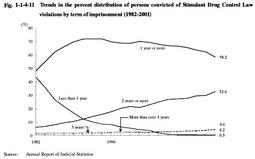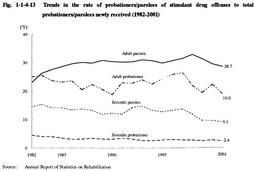| Previous Next Index Image Index Year Selection | |
|
|
3 Treatment of drug offenders (1) Disposition by public prosecutors offices Fig. 1-1-4-10 shows the trends in the rates of prosecution for Stimulant Drug Control Law violations, Narcotics Control Law violations, and Cannabis Control Law violations in the last 20 years. Stimulant Drug Control Law violations, which had been hovering within the range of 85% or over but below 90%, exceeded 90% in 2000 and reached 90.2% in 2001. Narcotics Control Law violations, which had been consistently on the rise since 1997, moderately fell to 72.3% in 2001. Cannabis Control Law violations, which had been generally on the rise since 1995 and hit its highest level in the last 20 years in 2000, at 68.2%, increased further to 71.4% in 2001 (see Appendix 1-6 ).
Fig. 1-1-4-10 Trends in the rates of prosecution for Stimulant Drug Control Law violations, Narcotics Control Law violations, and Cannabis Control Law violations (1982-2001) (2) Disposition of courts Fig. 1-1-4-11 shows the trends in the percent distribution of persons sentenced to imprisonment with labor for Stimulant Drug Control Law violations by ordinary first instances for the last 20 years, by the term of imprisonment. The rate of persons sentenced to imprisonment with labor for less than 1 year dropped sharply after reaching 43.5% in 1982, and then has fallen below 1% since 1996. On the contrary, the persons sentenced to imprisonment with labor for 2 years or more and not more than 3 years, and those sentenced for 3 years and more increased their shared percent distributions. From these figures, it can be considered that sentence has been becoming heavier than before.
Fig. 1-1-4-11 Trends in the percent distribution of persons convicted of Stimulant Drug Control Law violations by term of imprisonment (1982-2001) (3) Correction Stimulant drug offense is one of the most dominant type of crimes of inmates detained in penalinstitutions and juvenile training schools. All of the penal institutions and juvenile training schools, where inmates for stimulant drug offenses are detained, have special treatment programs for the education of inmates. It can be pointed out that recent education programs are marked by employing various staff members, not only staff from institutions and schools, but also outside professionals.
Fig. 1-1-4-12 shows the trends in the percent distribution of inmates convicted of stimulant drug offenses by age group, in 5 year periods since 1981. The number of inmates convicted of stimulant drug offenses was greatest among persons aged 30-39 until 1984, and then, among those aged 40-49. However, those aged 30-39 have also had the largest share in recent years. On the other hand, those inmates convicted of stimulant drug offenses are rapidly aging, showing a gradual increase in persons aged 50-59 and over 60. (4) Rehabilitation Probation offices practice special guidance, as one of the categorized treatment systems, establishing a system under which probation officers directly decide the term of guidance for probationers/parolees of stimulant drug offenses in consideration of their characters.
Fig. 1-1-4-13 shows the trends in the rate of probationers/parolees newly received for stimulant drug offenses to all probationers/parolees newly received, for the last 20 years. The rate of adult parolees has almost consistently increased since 1982. However, it has been decreasing recently after peaking in 1998, and decreased to 28.7% in 2001. Fig. 1-1-4-12 Trends in the percent distribution of offenders newly imprisoned for stimulant drug offenses by age group (1981, 1986, 1991, 1996, 2001) Fig. 1-1-4-13 Trends in the rate of probationers/parolees of stimulant drug offenses to total probationers/parolees newly received (1982-2001) Explanation of termsMoney laundering: Money laundering refers to the process by which offenders disguise the origin of proceeds of drug offenses, etc, and make the proceeds look like the profits gained from legal commercial transactions; for example, the act of transferring money through a series of bank accounts. Controlled delivery: Controlled delivery refers to an investigative technique that allows specific consignments of illicit drugs to be distributed under close observation without immediate seizure. The objective of controlled delivery is not only to identify the person who received the drug, but also to permit successful clearance of persons involved in the transactions. On the other hand, "clean controlled delivery" refers to an investigative technique that removes illicit drugs which were discovered by the police, etc, but allows a consignment of alternatives substituted for the illicit drugs to be distributed. Confiscation: Confiscation refers to a pecuniary penalty which transfers the ownership of materials related to offenses to the state. This aims to prevent offenders from enjoying illicit proceeds and to remove the harmful materials such as stimulant drugs, etc. from society. Collection of the corresponding value to be confiscated: Collection of the corresponding value to be confiscated refers to a penalty of paying to the state the amount of money corresponding to the value of the goods in question, in the case where confiscation could not be conducted or was only partially achieved. |



